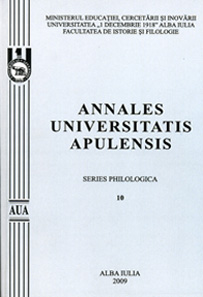BASMELE LUI ION CREANGĂ CA O CONEXIUNE ÎNTRE FOLCLORUL ROMÂNESC ŞI CEL SLAV
Tales Written by the Romanian Author Ion Creangă - CONNECTION BETWEEN ROMANIAN AND SLAVIC FOLKLORE
Author(s): Rafał RykowskiSubject(s): Customs / Folklore
Published by: Universitatea »1 Decembrie 1918« Alba Iulia
Keywords: folk tales; Ion Creangă; mythology Romanian tales and Slavic folklore.
Summary/Abstract: In the tales written by the Romanian author Ion Creangă, we can see a lot of motifs in common with those from well-known Slavic folk tales. These motifs are not only the stories themselves, but also the characters’ features that can be compared to the Slavic ones. According to folklorists such as V. Propp and I. Chiţimia, the circulation of oral folklore motifs and names is much larger than those in the written literature, and the fact that the Romanian territories are surrounded by Slavic countries which enabled a tight contact explains such interferences. These motifs that are to be found both in the Romanian tales and in the Slavic ones are of different types: the role of the characters, their characteristics, their names, consequently imaginary, literary and linguistic aspects of folklore-based tales. An interesting motif can be found in the tale Făt-Frumos fiul iepei, where there are some reminiscences of a widespread motif of the fight between the hero and a dragon on a bridge. This motif, which is most often found in the Eastern-Slavic territories, but also among Baltic and Turkic peoples of the former Soviet Union, is almost inexistent in Western European tales, as well as in Eastern Asia. Nevertheless it is present in some other Romanian tales, mainly in the well-known Greuceanu, where it appears next to the presence of the character the Earth Blacksmith (Faurul pământului), which is typical also for the Eastern-Slavic tales. The tale Greuceanu is very close to the tale-pattern known especially in post-Soviet are Besides the motif of the fight on the bridge, in the tale Făt-Frumos fiul iepei we can see a lot of motifs similar especially with Russian and Ukrainian tales: the presence of two evil giants, the extremely rapid growth of the hero, the descent into the Underground and the presence of a strange characters i.e. a little evil old man with a long beard. The last motif is characteristic also for the Southern Slavic tales, but the way in which this character is described in Romanian tales is very close to the descriptions in Eastern Slavic and Avar (the Caucassian people) tales. On the other hand, the presence of two giants shows that the tale belongs to the type 301AT (The treacherous brothers, or The Three Kidnapped Princesses) in the Aarne-Thompson System, being genetically connected to the type AT 300, The dragon slayer, and its origin is in the East. The second of Creangă's tales is Povestea lui Harap Alb, which contains a lot of characters and motifs similar to the ones in the Eastern-Slavic area, which are almost inexistent in Western Europe. There are some supernatural men, with special charts: for example one can eat ceaselessly, another can see all that happens wherever in the world. Therefore, we can speak about a common territory of imaginary interferences in Eastern Europe, especially among Orthodox peoples, where interethnic contacts favoured the spreading of folklore motifs.
Journal: Annales Universitatis Apulensis. Series Philologica
- Issue Year: 11/2010
- Issue No: 1
- Page Range: 165-176
- Page Count: 12
- Language: Romanian

